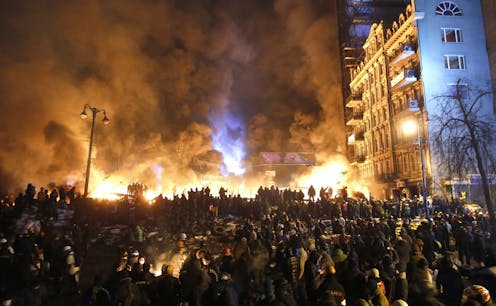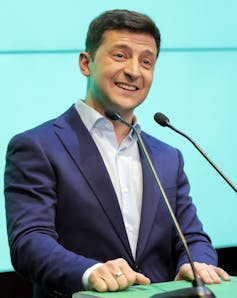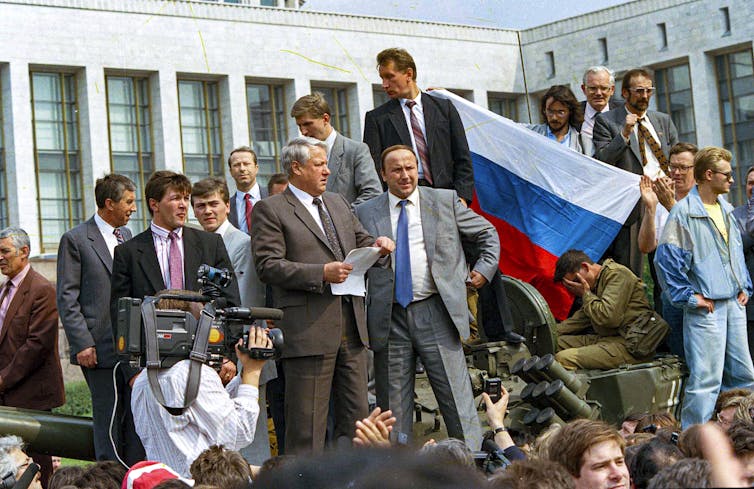
“Hello Dear Mark: the number of victims in Kyiv is growing every day (people are dying in the hospitals) and is already 100 … My family is OK. I just need to explain to my nearly 6 year old girl why people are flying to the sky forever and what ‘war’ means.”
Those words, sent from one of my former students in Ukraine, could have been written last week. In reality, they were sent eight years ago after the brutal suppression of protests by Ukraine’s last Russian-backed president, Viktor Yanukovych.
Known as the Euromaidan Revolution (or “Revolution of Dignity”), the protests were sparked by Yanukovych’s refusal to sign the popular European Union-Ukraine Association Agreement and the Deep and Comprehensive Trade Agreement, both of which would have strengthened ties between Ukraine and the EU. Public anger against Yanukovych was so high after the bloodshed that he was forced to leave the country.
Long road to democratic reform
In the wake of the Euromaidan Revolution, Russian President Vladimir Putin realized there was unlikely to be another elected pro-Russian Ukranian president, leading him to annex the Crimean peninsula and incite separatist violence in the Donbas region in 2014.
The Euromaidan was a turning point for Ukraine’s institutions. The country’s 1996 constitution featured a formally semi-presidential system with loopholes for presidential influence. At that time, the country effectively had a presidential system under then-president Leonid Kuchma, who routinely engaged in election fraud and harassed political opponents.
Kuchma’s drift toward authoritarianism was eventually stopped by massive protests during the Orange Revolution of 2004, but the constitutional amendments of that year limiting presidential power (in particular, giving parliament, instead of the president, the right to choose the prime minister) were reversed as soon as Yanukovych became president in 2010.
It was not until 2014 when the kind of constitutional reform needed to secure Ukraine’s long-term democratic consolidation, economic development and political stability started to happen with the election of President Petro Poroschenko.

Poroschenko came to power by tapping into the post-Euromaidan hope that rampant corruption would be brought under control. Yet this was belied by his own career as a billionaire oligarch who has been accused of selling political influence.
Scandals during Poroschenko’s term as president led to his defeat in 2019 by political novice Volodomyr Zelensky, who turned his lack of legislative experience into a political asset.
Presidential power
The continuing lack of constitutional change in Ukraine is rooted in the post-Soviet belief in strong presidents — whether they were pro-Russian or pro-western — who could impose their will upon the legislatures, where opposition to reform was most concentrated. The ruling wisdom in Ukraine, as in most of Eastern Europe, was that presidents could more easily inflict short-term pain for long-term gain.
That is why, when I was a university instructor in Poland and Ukraine in the 1990s, I had a hard time selling the idea of Westminister-style parliamentary government to my students and academic colleagues.
Pointing primarily to published studies of political instability among presidential regimes in Latin America and elsewhere, I argued that parliamentary regimes were generally more conducive to power-sharing and consociational democracy: the building of political alliances where all major segments of society are either proportionally represented in government or allowed local autonomy.
The bias against parliamentarism began to change with the Orange Revolution, a series of protests that took place after credible allegations of electoral fraud were levelled against the pro-Russian government in 2004.
But for most Ukrainians, putting executive power in the hands of a parliamentary government was a non-starter. The legacy of communism and the corrupt reputation of the legislature did not change with the replacement of old communists with new oligarchs.
Paving the way for Putin
Nowhere was this perceived need for a strong presidency greater than in Russia. In 1992, the president of the Russian republic, Boris Yeltsin, made a unilateral declaration on Sept. 21, 1993, to dissolve the Congress of People’s Deputies and the Supreme Soviet.
Although in flagrant violation of the existing constitution, it received widespread support from western powers — especially the United States, which was focused on preserving market reforms.

Although Yeltsin’s new constitution aspired to create a more democratic and law-based country, it concentrated a significant amount of power in the hands of the president and sowed the seeds for a future de facto dictatorship in the hands of his chosen successor, Vladimir Putin.
In 2020, Putin easily avoided the requirement of a constitutional convention for fundamental changes by passing 200 amendments of his own that, for example, recognized his authority to dismiss judges and placed the parliamentary executive “under the general leadership of the president.”
Could things have been different?
Given the growing support for European integration in most of Ukraine, and the unacceptability of that result to the Kremlin, was the possibility of compromise between Ukraine and Russia always hopeless? Was the war inevitable?
Under a different constitution, Ukraine could have ensured that Russian-speaking regions had both a greater measure of local autonomy and a stronger voice in the national parliament. A head of government tasked with consensus-building in such a political environment might have been able to find a more realistic and less provocative path to a western future — one inside the EU, but still outside of NATO.
A peaceful outcome would have also been more likely if Russia’s leader — legally restrained at home by a more independent judiciary, a freer press and an effective parliamentary opposition — had been forced to accept decentralization as the solution to the conflict in eastern Ukraine, and to also accept the legitimacy of the EU-Ukraine Association Agreement.
But in both countries, a perceived need for enhanced presidential power inherited from the early days of post-communist transition had already reduced the likelihood of compromise, setting them both on a collision course.
Mark Crawford does not work for, consult, own shares in or receive funding from any company or organisation that would benefit from this article, and has disclosed no relevant affiliations beyond their academic appointment.
This article was originally published on The Conversation. Read the original article.







